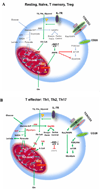The role of metabolic reprogramming in T cell fate and function
- PMID: 28356677
- PMCID: PMC5367635
The role of metabolic reprogramming in T cell fate and function
Abstract
T lymphocytes undergo extensive changes in their metabolic properties during their transition through various differentiation states, from naïve to effector to memory or regulatory roles. The cause and effect relationship between metabolism and differentiation is a field of intense investigation. Many recent studies demonstrate the dependency of T cell functional outcomes on metabolic pathways and the possibility of metabolic intervention to modify these functions. In this review, we describe the basic metabolic features of T cells and new findings on how these correlate with various differentiation fates and functions. We also highlight the latest information regarding the main factors that affect T cell metabolic reprogramming.
Keywords: T lymphocytes; differentiation fate and function; metabolism.
Conflict of interest statement
CONFLICT OF INTEREST STATEMENT The authors have no competing conflict of interest.
Figures

Similar articles
-
The effect of immunosuppressive molecules on T-cell metabolic reprogramming.Biochimie. 2016 Aug;127:23-36. doi: 10.1016/j.biochi.2016.04.016. Epub 2016 Apr 25. Biochimie. 2016. PMID: 27126071 Review.
-
Immunometabolism of T cells and NK cells: metabolic control of effector and regulatory function.Inflamm Res. 2018 Oct;67(10):813-828. doi: 10.1007/s00011-018-1174-3. Epub 2018 Jul 31. Inflamm Res. 2018. PMID: 30066126 Review.
-
Clinical significance of T cell metabolic reprogramming in cancer.Clin Transl Med. 2016 Dec;5(1):29. doi: 10.1186/s40169-016-0110-9. Epub 2016 Aug 10. Clin Transl Med. 2016. PMID: 27510264 Free PMC article. Review.
-
Metabolic Control of Memory T-Cell Generation and Stemness.Cold Spring Harb Perspect Biol. 2021 Jun 1;13(6):a037770. doi: 10.1101/cshperspect.a037770. Cold Spring Harb Perspect Biol. 2021. PMID: 33820774 Free PMC article. Review.
-
Metabolic orchestration of T lineage differentiation and function.FEBS Lett. 2017 Oct;591(19):3104-3118. doi: 10.1002/1873-3468.12849. Epub 2017 Oct 6. FEBS Lett. 2017. PMID: 28901530 Review.
Cited by
-
Transcriptional and functional remodeling of lung-resident T cells and macrophages by Simian varicella virus infection.Front Immunol. 2024 Jun 3;15:1408212. doi: 10.3389/fimmu.2024.1408212. eCollection 2024. Front Immunol. 2024. PMID: 38887303 Free PMC article.
-
Immune microenvironment of the gene signature reflecting the standardised uptake value on 18F-fluorodeoxyglucose positron emission tomography/computed tomography in head and neck squamous cell carcinoma.Ann Nucl Med. 2021 Jan;35(1):65-75. doi: 10.1007/s12149-020-01537-9. Epub 2020 Oct 12. Ann Nucl Med. 2021. PMID: 33044632
-
T-Cell Exhaustion in Chronic Infections: Reversing the State of Exhaustion and Reinvigorating Optimal Protective Immune Responses.Front Immunol. 2018 Nov 9;9:2569. doi: 10.3389/fimmu.2018.02569. eCollection 2018. Front Immunol. 2018. PMID: 30473697 Free PMC article. Review.
-
The Epithelial-Mesenchymal Transition Influences the Resistance of Oral Squamous Cell Carcinoma to Monoclonal Antibodies via Its Effect on Energy Homeostasis and the Tumor Microenvironment.Cancers (Basel). 2021 Nov 24;13(23):5905. doi: 10.3390/cancers13235905. Cancers (Basel). 2021. PMID: 34885013 Free PMC article. Review.
-
Lipid metabolic features of T cells in the Tumor Microenvironment.Lipids Health Dis. 2022 Oct 6;21(1):94. doi: 10.1186/s12944-022-01705-y. Lipids Health Dis. 2022. PMID: 36203151 Free PMC article. Review.
References
Grants and funding
LinkOut - more resources
Full Text Sources
